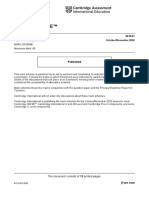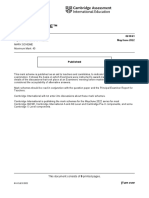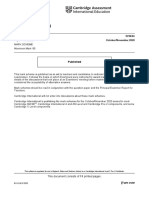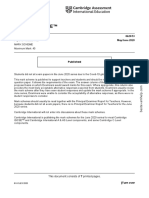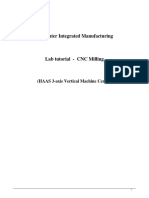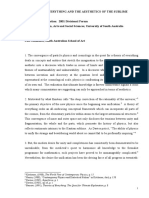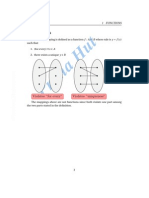Cambridge IGCSE™: Biology 0610/51 October/November 2020
Cambridge IGCSE™: Biology 0610/51 October/November 2020
Uploaded by
Saleha ShafiqueCopyright:
Available Formats
Cambridge IGCSE™: Biology 0610/51 October/November 2020
Cambridge IGCSE™: Biology 0610/51 October/November 2020
Uploaded by
Saleha ShafiqueOriginal Title
Copyright
Available Formats
Share this document
Did you find this document useful?
Is this content inappropriate?
Copyright:
Available Formats
Cambridge IGCSE™: Biology 0610/51 October/November 2020
Cambridge IGCSE™: Biology 0610/51 October/November 2020
Uploaded by
Saleha ShafiqueCopyright:
Available Formats
Cambridge IGCSE™
BIOLOGY 0610/51
Paper 5 Practical Test October/November 2020
MARK SCHEME
Maximum Mark: 40
Published
This mark scheme is published as an aid to teachers and candidates, to indicate the requirements of the
examination. It shows the basis on which Examiners were instructed to award marks. It does not indicate the
details of the discussions that took place at an Examiners’ meeting before marking began, which would have
considered the acceptability of alternative answers.
Mark schemes should be read in conjunction with the question paper and the Principal Examiner Report for
Teachers.
Cambridge International will not enter into discussions about these mark schemes.
Cambridge International is publishing the mark schemes for the October/November 2020 series for most
Cambridge IGCSE™, Cambridge International A and AS Level and Cambridge Pre-U components, and some
Cambridge O Level components.
This document consists of 8 printed pages.
© UCLES 2020 [Turn over
0610/51 Cambridge IGCSE – Mark Scheme October/November 2020
PUBLISHED
Generic Marking Principles
These general marking principles must be applied by all examiners when marking candidate answers. They should be applied alongside the
specific content of the mark scheme or generic level descriptors for a question. Each question paper and mark scheme will also comply with these
marking principles.
GENERIC MARKING PRINCIPLE 1:
Marks must be awarded in line with:
• the specific content of the mark scheme or the generic level descriptors for the question
• the specific skills defined in the mark scheme or in the generic level descriptors for the question
• the standard of response required by a candidate as exemplified by the standardisation scripts.
GENERIC MARKING PRINCIPLE 2:
Marks awarded are always whole marks (not half marks, or other fractions).
GENERIC MARKING PRINCIPLE 3:
Marks must be awarded positively:
• marks are awarded for correct/valid answers, as defined in the mark scheme. However, credit is given for valid answers which go beyond the
scope of the syllabus and mark scheme, referring to your Team Leader as appropriate
• marks are awarded when candidates clearly demonstrate what they know and can do
• marks are not deducted for errors
• marks are not deducted for omissions
• answers should only be judged on the quality of spelling, punctuation and grammar when these features are specifically assessed by the
question as indicated by the mark scheme. The meaning, however, should be unambiguous.
GENERIC MARKING PRINCIPLE 4:
Rules must be applied consistently, e.g. in situations where candidates have not followed instructions or in the application of generic level
descriptors.
© UCLES 2020 Page 2 of 8
0610/51 Cambridge IGCSE – Mark Scheme October/November 2020
PUBLISHED
GENERIC MARKING PRINCIPLE 5:
Marks should be awarded using the full range of marks defined in the mark scheme for the question (however; the use of the full mark range may
be limited according to the quality of the candidate responses seen).
GENERIC MARKING PRINCIPLE 6:
Marks awarded are based solely on the requirements as defined in the mark scheme. Marks should not be awarded with grade thresholds or
grade descriptors in mind.
Science-Specific Marking Principles
1 Examiners should consider the context and scientific use of any keywords when awarding marks. Although keywords may be present, marks
should not be awarded if the keywords are used incorrectly.
2 The examiner should not choose between contradictory statements given in the same question part, and credit should not be awarded for
any correct statement that is contradicted within the same question part. Wrong science that is irrelevant to the question should be ignored.
3 Although spellings do not have to be correct, spellings of syllabus terms must allow for clear and unambiguous separation from other
syllabus terms with which they may be confused (e.g. ethane / ethene, glucagon / glycogen, refraction / reflection).
4 The error carried forward (ecf) principle should be applied, where appropriate. If an incorrect answer is subsequently used in a scientifically
correct way, the candidate should be awarded these subsequent marking points. Further guidance will be included in the mark scheme
where necessary and any exceptions to this general principle will be noted.
5 ‘List rule’ guidance
For questions that require n responses (e.g. State two reasons …):
• The response should be read as continuous prose, even when numbered answer spaces are provided.
• Any response marked ignore in the mark scheme should not count towards n.
• Incorrect responses should not be awarded credit but will still count towards n.
• Read the entire response to check for any responses that contradict those that would otherwise be credited. Credit should not be
awarded for any responses that are contradicted within the rest of the response. Where two responses contradict one another, this
should be treated as a single incorrect response.
• Non-contradictory responses after the first n responses may be ignored even if they include incorrect science.
© UCLES 2020 Page 3 of 8
0610/51 Cambridge IGCSE – Mark Scheme October/November 2020
PUBLISHED
6 Calculation specific guidance
Correct answers to calculations should be given full credit even if there is no working or incorrect working, unless the question states ‘show
your working’.
For questions in which the number of significant figures required is not stated, credit should be awarded for correct answers when rounded
by the examiner to the number of significant figures given in the mark scheme. This may not apply to measured values.
For answers given in standard form (e.g. a × 10n) in which the convention of restricting the value of the coefficient (a) to a value between 1
and 10 is not followed, credit may still be awarded if the answer can be converted to the answer given in the mark scheme.
Unless a separate mark is given for a unit, a missing or incorrect unit will normally mean that the final calculation mark is not awarded.
Exceptions to this general principle will be noted in the mark scheme.
7 Guidance for chemical equations
Multiples / fractions of coefficients used in chemical equations are acceptable unless stated otherwise in the mark scheme.
State symbols given in an equation should be ignored unless asked for in the question or stated otherwise in the mark scheme.
mark scheme abbreviations
• ; separates marking points
• / alternative responses for the same marking point
• ecf error carried forward
• AVP any valid point
• ora or reverse argument
• underline actual word given must be used by candidate (grammatical variants excepted)
• () the word / phrase in brackets is not required but sets the context
• max indicates the maximum number of marks
• Any [number] of: accept the [number] of valid responses
• R reject
• A accept (for answers correctly cued by the question, or guidance for examiners)
• I ignore as irrelevant
• AW alternative wording (where responses vary more than usual)
• AVP alternative valid point
• max indicates the maximum number of marks that can be given
© UCLES 2020 Page 4 of 8
0610/51 Cambridge IGCSE – Mark Scheme October/November 2020
PUBLISHED
Question Answer Marks Guidance
1(a)(i) 0.5(%) ; 1
1(a)(ii) table drawn with a minimum of two columns and a header line ; 4
column and row headings with units ; percentage concentration of lipase and time / s
correct time recorded in seconds for each concentration ;
suitable trend in the data ; check supervisor’s report
1(a)(iii) as the, enzyme / lipase, concentration / percentage, increases the time to 1
change colour, decreases / is faster ; ora
the higher the enzyme concentration the faster the, fat / milk, is broken
down /AW ;
1(b)(i) control: distilled water / L4 / 0% lipase ; 2
explanation: to show that lipase / enzyme is causing the change (of
colour in the indicator) ;
1(b)(ii) expected: L1 = 6 and L4 = 8 ; 1 check candidate’s data / supervisor’s report
1(b)(iii) any two from: 2
volume of milk ;
total volume, of (enzyme) solution ;
volume of sodium carbonate solution ;
number of drops of, indicator / bromothymol blue, used ;
AVP ;
1(b)(iv) to give enough time for the (contents of the) test-tubes to, reach the 1
temperature of the water-bath / equilibrate AW ;
1(b)(v) idea of: colour change is subjective / end-point is hard to judge ; 1
© UCLES 2020 Page 5 of 8
0610/51 Cambridge IGCSE – Mark Scheme October/November 2020
PUBLISHED
Question Answer Marks Guidance
1(c) add biuret, reagent /solution (to lipase solution) ; 3
colour change (from blue) to purple / lilac / violet / mauve ;
wear gloves / safety glasses / goggles ;
1(d) independent variable 6
1 at least three temperatures ;
2 one below 37°C, one above 37°C, and one at 37°C ;
new method
3 method of maintaining temperature described ;
4 named alternative sources of fat ;
5 correct reference to emulsion test
6 correct reference to use of a different indicator, e.g. UI
7 and 8 max 2 from given method ;;
• same, volume of sodium carbonate
• same number of drops of indicator
• same volume of milk
• measure time taken for indicator to change colour
• idea of equilibrate enzyme and milk before mixing / AW
9 and 10 max 2 from variables kept constant ;;
• same volume of indicator
• same type of milk / fat
• same volume of fat ;
• same amount / volume / concentration, of lipase
11 ref. to two or more repeats ;
© UCLES 2020 Page 6 of 8
0610/51 Cambridge IGCSE – Mark Scheme October/November 2020
PUBLISHED
Question Answer Marks Guidance
2(a) 3 one mark per row
letter on Fig. 2.2 name of flower part number visible
A stigma 1
B filament 8
C sepal 4
;;;
2(b)(i) lines: clear single outer line without shading ; 5
size: X–Y bigger than 35 mm ;
rounded structures inside grain ;
pollen tube top edge with one indentation ;
label to pollen tube ;
2(b)(ii) line XY 35 ± 1 (mm) ; 3 MP1 correct measurement
0.1 mm / 100 μm ;; MP2 correct calculation
A ecf measurement ÷ 350
MP3 correct unit
2(c)(i) any two from: 2
pollen germinated faster / germination rate is higher, in S1 (than S2) (at
the start) / AW ; ora
by 60 minutes no difference between (percentage germination) in S1 and
S2 ;
(pollen in) S1 stops germinating after 50 minutes / AW ;
only 51% / not all pollen grains, germinated ;
2(c)(ii) Idea that different numbers of pollen were counted on each slide ; 1
2(c)(iii) divide the number germinated by the total ; 2
multiply by 100 ;
© UCLES 2020 Page 7 of 8
0610/51 Cambridge IGCSE – Mark Scheme October/November 2020
PUBLISHED
Question Answer Marks Guidance
2(d) y-axis scaled correctly with suitable numbers ; 2
plot for B and C correct and labelled ;
© UCLES 2020 Page 8 of 8
You might also like
- Asset-V1 MITx+18.6501x+3T2019+type@asset+block@resources Syllabus Schedule 3T2019Document3 pagesAsset-V1 MITx+18.6501x+3T2019+type@asset+block@resources Syllabus Schedule 3T2019AkashBisht50% (2)
- UUID or GUID As Primary Keys Be CarefulDocument33 pagesUUID or GUID As Primary Keys Be Carefulleonard1971100% (1)
- Cambridge IGCSE™: Biology 0610/61 October/November 2020Document8 pagesCambridge IGCSE™: Biology 0610/61 October/November 2020Yuli Prapita SariNo ratings yet
- Cambridge IGCSE™: Biology 0610/53 October/November 2020Document8 pagesCambridge IGCSE™: Biology 0610/53 October/November 2020Saleha ShafiqueNo ratings yet
- Cambridge IGCSE™: Biology 0610/63 October/November 2020Document8 pagesCambridge IGCSE™: Biology 0610/63 October/November 2020CNo ratings yet
- November 2020 Mark Scheme Paper 51Document8 pagesNovember 2020 Mark Scheme Paper 51SULTAN SURGANo ratings yet
- November 2020 Mark Scheme Paper 36Document8 pagesNovember 2020 Mark Scheme Paper 36Siya PathakNo ratings yet
- Cambridge International AS & A Level: Biology 9700/35 October/November 2021Document8 pagesCambridge International AS & A Level: Biology 9700/35 October/November 2021lllllisaNo ratings yet
- Cambridge IGCSE ™: Biology 0610/61 October/November 2022Document9 pagesCambridge IGCSE ™: Biology 0610/61 October/November 2022ramloghun veerNo ratings yet
- Cambridge IGCSE™: Biology 0610/41 October/November 2020Document13 pagesCambridge IGCSE™: Biology 0610/41 October/November 2020Agus Ahmadi IrvanNo ratings yet
- Cambridge IGCSE™: Biology 0610/62 March 2020Document8 pagesCambridge IGCSE™: Biology 0610/62 March 2020Hendry RaoNo ratings yet
- Cambridge IGCSE™: Biology 0610/52 March 2020Document8 pagesCambridge IGCSE™: Biology 0610/52 March 2020Saleha ShafiqueNo ratings yet
- Cambridge International AS & A Level: Biology 9700/34 October/November 2021Document8 pagesCambridge International AS & A Level: Biology 9700/34 October/November 2021lllllisaNo ratings yet
- Cambridge IGCSE™: Biology 0610/61 October/November 2021Document8 pagesCambridge IGCSE™: Biology 0610/61 October/November 2021bocciamercedesNo ratings yet
- Cambridge IGCSE™: Biology 0610/41 October/November 2020Document13 pagesCambridge IGCSE™: Biology 0610/41 October/November 2020Zainab MohammedNo ratings yet
- Cambridge IGCSE ™: BiologyDocument7 pagesCambridge IGCSE ™: BiologyTom TommmaNo ratings yet
- Cambridge IGCSE™: Physics 0625/62 March 2020Document10 pagesCambridge IGCSE™: Physics 0625/62 March 2020KNEWTON EducationNo ratings yet
- Cambridge IGCSE™: Physics 0625/52 March 2020Document11 pagesCambridge IGCSE™: Physics 0625/52 March 2020KNEWTON EducationNo ratings yet
- Cambridge IGCSE™ (9-1) : BIOLOGY (9-1) 0970/61 May/June 2020Document8 pagesCambridge IGCSE™ (9-1) : BIOLOGY (9-1) 0970/61 May/June 2020Anisa KhanamNo ratings yet
- Cambridge International AS & A Level: Biology 9700/33 October/November 2021Document8 pagesCambridge International AS & A Level: Biology 9700/33 October/November 2021lllllisaNo ratings yet
- Cambridge IGCSE ™: Biology 0610/52Document9 pagesCambridge IGCSE ™: Biology 0610/52AHMADNo ratings yet
- Cambridge IGCSE™: Biology 0610/62 October/November 2021Document9 pagesCambridge IGCSE™: Biology 0610/62 October/November 2021EffNo ratings yet
- Cambridge IGCSE™: Biology 0610/61 May/June 2022Document9 pagesCambridge IGCSE™: Biology 0610/61 May/June 2022Bashir SsekalegaNo ratings yet
- Igcse Biology0610 Variant 2 May/june 2020Document12 pagesIgcse Biology0610 Variant 2 May/june 2020sally.mansterlyNo ratings yet
- Cambridge IGCSE ™: Biology 0610/63 October/November 2022Document8 pagesCambridge IGCSE ™: Biology 0610/63 October/November 2022ramloghun veerNo ratings yet
- Cambridge International AS & A Level: Biology 9700/21 October/November 2020Document13 pagesCambridge International AS & A Level: Biology 9700/21 October/November 2020Sinin VegaNo ratings yet
- 9700 w22 Ms 53 PDFDocument11 pages9700 w22 Ms 53 PDFQian LuNo ratings yet
- Cambridge International AS & A Level: Biology 9700/33Document6 pagesCambridge International AS & A Level: Biology 9700/33张查No ratings yet
- Cambridge IGCSE™: Biology 0610/63Document9 pagesCambridge IGCSE™: Biology 0610/63wahajmohammed51No ratings yet
- Cambridge IGCSE™: Biology 0610/53 May/June 2021Document7 pagesCambridge IGCSE™: Biology 0610/53 May/June 2021Irvine MupambaNo ratings yet
- Cambridge International AS & A Level: Biology 9700/33 October/November 2022Document6 pagesCambridge International AS & A Level: Biology 9700/33 October/November 2022mariakhan.educationNo ratings yet
- Cambridge IGCSE™: Biology 0610/42 October/November 2021Document13 pagesCambridge IGCSE™: Biology 0610/42 October/November 2021iantanyq1234No ratings yet
- Cambridge IGCSE ™: Biology 0610/62 October/November 2022Document10 pagesCambridge IGCSE ™: Biology 0610/62 October/November 2022vanshrajsinh9No ratings yet
- Cambridge International AS & A Level: Biology 9700/43 May/June 2022Document23 pagesCambridge International AS & A Level: Biology 9700/43 May/June 2022Aneeqa KhanNo ratings yet
- Cambridge International AS & A Level: Biology 9700/52 May/June 2020Document9 pagesCambridge International AS & A Level: Biology 9700/52 May/June 2020Aneeqa KhanNo ratings yet
- Cambridge International AS & A Level: Biology 9700/31Document7 pagesCambridge International AS & A Level: Biology 9700/31LongNo ratings yet
- Cambridge International AS & A Level: Biology 9700/42 May/June 2020Document20 pagesCambridge International AS & A Level: Biology 9700/42 May/June 2020justinNo ratings yet
- Cambridge International AS & A Level: Biology 9700/34 May/June 2022Document8 pagesCambridge International AS & A Level: Biology 9700/34 May/June 2022mariakhan.educationNo ratings yet
- Cambridge IGCSE ™: Biology 0610/62 October/November 2022Document10 pagesCambridge IGCSE ™: Biology 0610/62 October/November 2022ramloghun veerNo ratings yet
- 9700 w22 Ms 42 PDFDocument19 pages9700 w22 Ms 42 PDFManha KhalidNo ratings yet
- Cambridge IGCSE™: Biology 0610/62 May/June 2022Document8 pagesCambridge IGCSE™: Biology 0610/62 May/June 2022walsha khanNo ratings yet
- Cambridge International AS & A Level: Biology 9700/33 March 2020Document8 pagesCambridge International AS & A Level: Biology 9700/33 March 2020Mohamed HNo ratings yet
- 0610 w23 Ms 52pracigcseDocument8 pages0610 w23 Ms 52pracigcsedesrescottNo ratings yet
- Cambridge O Level: Biology 5090/61 October/November 2021Document7 pagesCambridge O Level: Biology 5090/61 October/November 2021saymaakter.ahisNo ratings yet
- Cambridge O Level: Biology 5090/61 May/June 2021Document7 pagesCambridge O Level: Biology 5090/61 May/June 2021Sasaki MeraNo ratings yet
- Cambridge IGCSE™: Biology 0610/63 May/June 2021Document7 pagesCambridge IGCSE™: Biology 0610/63 May/June 2021bali yunNo ratings yet
- Biology March Mark Scheme Paper 6Document7 pagesBiology March Mark Scheme Paper 6Muhammad ZiaNo ratings yet
- Cambridge IGCSE ™: Biology 0610/42 October/November 2022Document15 pagesCambridge IGCSE ™: Biology 0610/42 October/November 2022dudidam24No ratings yet
- Cambridge Pre-U: Biology 9790/04 October/November 2020Document11 pagesCambridge Pre-U: Biology 9790/04 October/November 2020rkblsistemNo ratings yet
- Cambridge IGCSE™: Biology 0610/42 February/March 2022Document12 pagesCambridge IGCSE™: Biology 0610/42 February/March 2022bali yunNo ratings yet
- 9700 - s20 - Ms - 42 Biologya2Document20 pages9700 - s20 - Ms - 42 Biologya2Fatahna KhanzadaNo ratings yet
- Cambridge IGCSE™ (9-1) : BIOLOGY (9-1) 0970/51 May/June 2020Document8 pagesCambridge IGCSE™ (9-1) : BIOLOGY (9-1) 0970/51 May/June 2020Anisa KhanamNo ratings yet
- Cambridge IGCSE™ (9-1) : BIOLOGY (9-1) 0970/51 May/June 2020Document8 pagesCambridge IGCSE™ (9-1) : BIOLOGY (9-1) 0970/51 May/June 2020Anisa KhanamNo ratings yet
- Cambridge Pre-U: Biology 9790/03 October/November 2020Document20 pagesCambridge Pre-U: Biology 9790/03 October/November 2020rkblsistemNo ratings yet
- Biology 0610 Paper 4 MSDocument12 pagesBiology 0610 Paper 4 MSgideon.cavidaNo ratings yet
- Cambridge IGCSE ™: Biology 0610/42 October/November 2022Document15 pagesCambridge IGCSE ™: Biology 0610/42 October/November 2022dharshini_perumalNo ratings yet
- Cambridge IGCSE™: Biology 0610/31 October/November 2020Document11 pagesCambridge IGCSE™: Biology 0610/31 October/November 2020bocciamercedesNo ratings yet
- Cambridge IGCSE™: Biology 0610/63Document8 pagesCambridge IGCSE™: Biology 0610/63manar mohamedNo ratings yet
- 0610 Paper 4 2022-24 MsDocument225 pages0610 Paper 4 2022-24 MsfocusedstudyingurlsNo ratings yet
- Cambridge IGCSE™: Chemistry 0620/53 May/June 2020Document7 pagesCambridge IGCSE™: Chemistry 0620/53 May/June 2020Diah SantyNo ratings yet
- Cambridge IGCSE ™: Physics 0625/33 October/November 2022Document13 pagesCambridge IGCSE ™: Physics 0625/33 October/November 2022Ar Ar ViNo ratings yet
- VMWARE Certified Spring Professional Certification Cased Based Practice Questions - Latest EditionFrom EverandVMWARE Certified Spring Professional Certification Cased Based Practice Questions - Latest EditionNo ratings yet
- Cambridge IGCSE™: Biology 0610/53 May/June 2020Document7 pagesCambridge IGCSE™: Biology 0610/53 May/June 2020Saleha ShafiqueNo ratings yet
- Cambridge IGCSE: BIOLOGY 0610/33Document20 pagesCambridge IGCSE: BIOLOGY 0610/33Saleha ShafiqueNo ratings yet
- Cambridge IGCSE: Biology 0610/13Document16 pagesCambridge IGCSE: Biology 0610/13Saleha ShafiqueNo ratings yet
- Cambridge IGCSE: BIOLOGY 0610/53Document12 pagesCambridge IGCSE: BIOLOGY 0610/53Saleha ShafiqueNo ratings yet
- Chapter 4 ChapterDocument7 pagesChapter 4 ChapterSaleha ShafiqueNo ratings yet
- Structural Analysis - Applications of Influence Line DiagramDocument2 pagesStructural Analysis - Applications of Influence Line DiagramAfia S HameedNo ratings yet
- 10 Cool Ways To Use Excel Conditional FormatingDocument19 pages10 Cool Ways To Use Excel Conditional Formatingfazhia pantheraNo ratings yet
- LECTURE 7: Finite Element Methods in Fracture MechanicsDocument7 pagesLECTURE 7: Finite Element Methods in Fracture MechanicsanandakoeNo ratings yet
- Elementary CalculusDocument346 pagesElementary CalculusFLNo ratings yet
- XFlow 2015 Change LogDocument6 pagesXFlow 2015 Change Logking kingNo ratings yet
- What Is Deep Learning?Document12 pagesWhat Is Deep Learning?kumarNo ratings yet
- 1 CH 1-2Document80 pages1 CH 1-2Ahmed AlarashiNo ratings yet
- Application of Derivatives in Daily LifeDocument1 pageApplication of Derivatives in Daily LifeFalcon Khan20% (5)
- Optimising Safety Relief and Flare SystemsDocument8 pagesOptimising Safety Relief and Flare SystemsJoseph McMullenNo ratings yet
- Single Phase PWM InverterDocument56 pagesSingle Phase PWM InverterMary Paulson100% (2)
- (Asad Syed Et Al 99) Understanding Risk Estimating The Contribution To Risk of Individual BetsDocument26 pages(Asad Syed Et Al 99) Understanding Risk Estimating The Contribution To Risk of Individual BetsGeorge ChenNo ratings yet
- Surge Impedance of Ground ConductorsDocument6 pagesSurge Impedance of Ground ConductorsDebasis_De_scribdNo ratings yet
- Lab 1 Osborne ReynoldsDocument11 pagesLab 1 Osborne Reynoldsali mustafaNo ratings yet
- 5510 0004 04 - 18 1021 Basic Principles of Ship Propulsion - MAN PDFDocument68 pages5510 0004 04 - 18 1021 Basic Principles of Ship Propulsion - MAN PDFAlex FatecNo ratings yet
- Lesson 03 Transient Response of Transmission LinesDocument9 pagesLesson 03 Transient Response of Transmission LinesArunabh BhattacharyaNo ratings yet
- CNC Milling (HAAS) Lab TutorialDocument20 pagesCNC Milling (HAAS) Lab Tutorialalexander0% (1)
- Theories of Everything and The AestheticDocument9 pagesTheories of Everything and The AestheticAbd JazNo ratings yet
- Delta Robot Simulator (Manual)Document4 pagesDelta Robot Simulator (Manual)Ahmad Bilal100% (1)
- Robotics Lab Project: Submitted To: Engr. Shehbaz Khan Group MembersDocument17 pagesRobotics Lab Project: Submitted To: Engr. Shehbaz Khan Group MembersAbdul Moiz QarniNo ratings yet
- Basic Problems in ElectroDynamicsDocument1 pageBasic Problems in ElectroDynamicsKarttikeya MangalamNo ratings yet
- Implicit Price Discrimination QuestionsDocument9 pagesImplicit Price Discrimination QuestionsthatsparklexNo ratings yet
- Neoclassical Growth ModelDocument21 pagesNeoclassical Growth ModelPrashantKNo ratings yet
- APO DP ForecastingDocument64 pagesAPO DP ForecastingKumar Rao100% (1)
- Relationship Between Service Quality and Customer Satisfaction The Study of The Catering IndustryDocument10 pagesRelationship Between Service Quality and Customer Satisfaction The Study of The Catering IndustryKerwin Chan Tsz ChungNo ratings yet
- Morales Corrected Lesson Plan 1Document11 pagesMorales Corrected Lesson Plan 1api-712929511No ratings yet
- Prima Hut: 1 FunctionsDocument30 pagesPrima Hut: 1 FunctionsRaju SharmaNo ratings yet
- UB2009 - Worksheet21Document3 pagesUB2009 - Worksheet21blahgzNo ratings yet
- The Final Eucleidian Solution For The Trisection of Random Acute Angle First Ever Presentation in The History of GeometryDocument3 pagesThe Final Eucleidian Solution For The Trisection of Random Acute Angle First Ever Presentation in The History of GeometryInternational Journal of Innovative Science and Research TechnologyNo ratings yet









